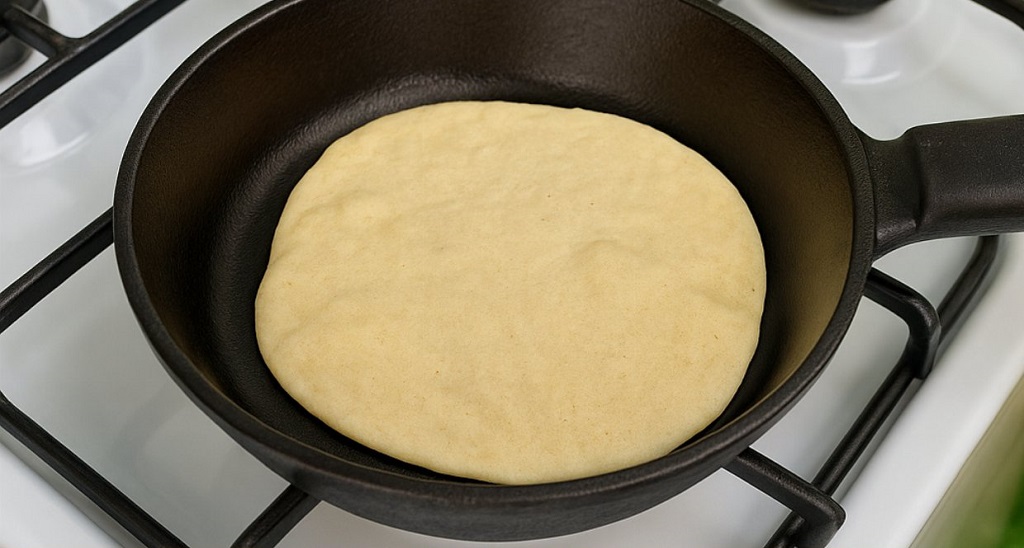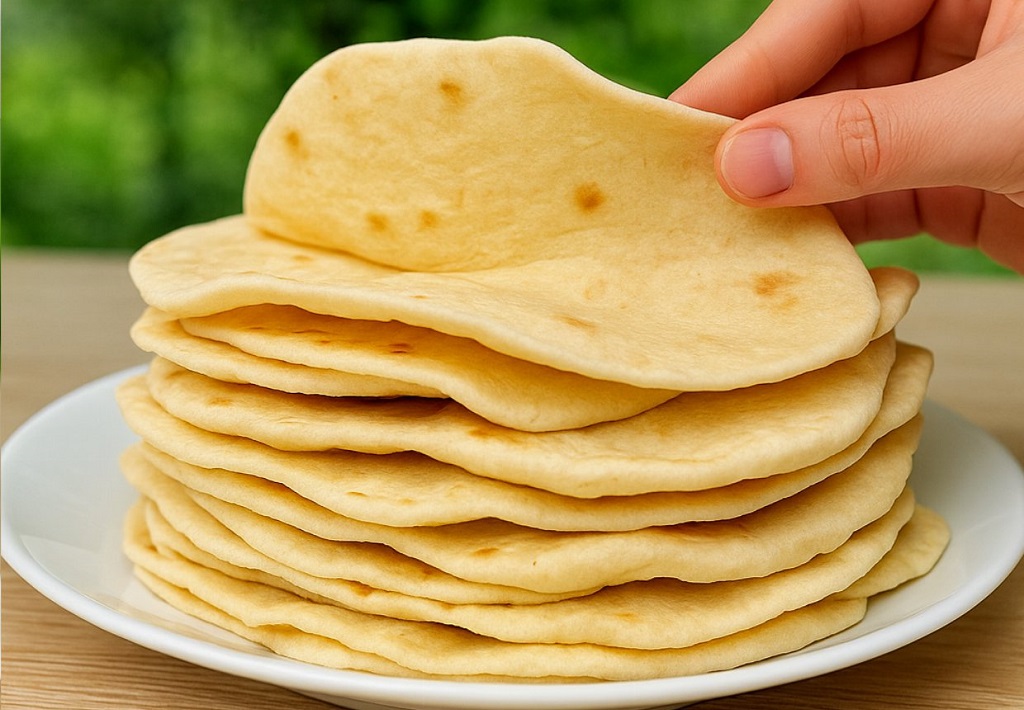I’ve been experimenting in my kitchen with healthy alternatives, and just eight words into this recipe, I knew I had found a winner: how to make oat flour dough without sugar or flour. It’s not only easy and quick, but also flexible, affordable, and surprisingly delicious. These soft, chewy oat pockets have become my go to flatbread alternative perfect for wraps, dipping, stuffing, or enjoying plain off the skillet. No sugar, no flour, no guilt.
“Soft, warm, flexible dough made from just oats and water? I’m obsessed!” – @CleanEatingChef
Why I Switched to This 3 Ingredient Oat Dough
I was tired of bloated, processed store bought breads full of sugar, preservatives, and bleached flour. I wanted something simpler something clean. That’s when I started working with oat flour. It’s naturally gluten free, rich in fiber, and neutral in flavor. When paired with warm water and a bit of oil, the result is a pliable, tender dough that cooks up golden and warm in just minutes.
- Gut friendly: High in soluble fiber and easy to digest
- Budget smart: Oat flour is cheap and can even be made from ground rolled oats
- No sugar crash: Zero added sugar or refined carbs
- Fast to make: Mix, rest, roll, and cook in under 30 minutes
It’s similar to how I prepare homemade naan or 10 minute skillet bread but even lighter and cleaner.
Ingredients for Oat Flour Dough (Makes 6-8 Pockets)
- 100 g oat flour (about 1 cup)
- ½ tsp baking powder
- ½ tsp fine salt
- 30 ml neutral oil (2 tablespoons – I use light olive oil or avocado oil)
- 90 ml warm water (about 6 tablespoons)
That’s it! No eggs, no dairy, no sugar, no flour. You can make your own oat flour by blending rolled oats into a fine powder using a food processor or blender. I’ve used both store bought and homemade oat flour both work beautifully.
Step by Step to Make Oat Flour Dough Without Sugar or Flour
1: Mix the Dry Ingredients
- In a medium mixing bowl, whisk together oat flour, baking powder, and salt.
- This helps prevent clumps and distributes the leavening evenly.
2: Add the Wet Ingredients
- Add the oil and warm water to the dry mixture.
- Use a spatula or wooden spoon to stir until a soft dough forms.
3: Knead Gently
- Once the dough comes together, use your hands to knead it gently in the bowl for about 1-2 minutes until smooth.
- If it feels sticky, add a small pinch of oat flour, if dry, add a splash more water.
4: Let It Rest
- Cover the bowl with a towel and let the dough rest for 10 minutes. This allows the oat flour to hydrate fully and makes rolling easier.
5: Divide and Roll
- Divide the dough into 6-8 equal balls.
- On a lightly floured surface (use oat flour), roll each ball into a circle about ⅛ inch thick. Don’t worry if it’s not perfectly round.
6: Cook on a Skillet
- Heat a dry non stick or cast iron skillet over medium heat.
- Cook each dough round for 1-2 minutes per side until golden spots appear and it puffs slightly.
- Transfer to a plate and cover with a clean towel to keep warm and soft.
“These oat flatbreads are so soft, you’d never guess they have no flour or sugar!” – @MinimalPantry

My Favorite Ways to Use This Oat Dough
Now that you know how to make oat flour dough without sugar or flour, you’ll find endless ways to enjoy it. I use these pockets for wraps, dips, tacos, or even homemade breakfast sandwiches. Their mild flavor makes them the perfect vessel for savory or sweet fillings.
- Stuffed with hummus and roasted veggies a great plant based lunch
- Filled with scrambled eggs and avocado protein rich breakfast on the go
- Served alongside soup or stew use them as clean eating dippers
- Topped with almond butter and banana a sweet and filling snack
- Made mini and served with dips perfect for parties or kids’ snacks
Much like our oat and chia bread or energy bits, this oat dough adapts to almost any craving or dietary need and keeps you full longer.
Why This Recipe Works Even Without Traditional Flour
Oat flour contains natural starch and a good amount of fiber, which allows it to form a pliable, dough like texture when mixed with warm water and a bit of oil. Unlike almond flour or coconut flour (which crumble), oat flour hydrates and binds beautifully.
The baking powder gives the dough just enough lightness so the pockets don’t turn out too dense. And the resting period? Absolutely essential. It softens the oats and activates the structure it’s the secret behind the soft, bendable final texture.
- No gluten? No problem: Oats are naturally gluten free and perfect for sensitive stomachs.
- Low glycemic: Helps keep your energy steady without the blood sugar spikes.
- Kid approved: Mild, soft, and fun to eat even picky eaters love them.
“It’s the kind of recipe that makes you feel good about every single bite.” – @CleanKitchenClub
How I Store and Reheat These Oat Flour Flatbreads
One of the best things about learning how to make oat flour dough without sugar or flour is discovering how well it stores. I usually make a double batch and keep these healthy pockets on hand all week they stay soft, fresh, and reheat like a dream.
- Room temperature: Stack the flatbreads, wrap tightly in foil or plastic, and store in a container for up to 2 days.
- Refrigerate: Store for up to 5 days in the fridge, sealed in an airtight bag or container.
- Freeze: Wrap each piece in parchment paper and freeze in a zip top bag. Thaw overnight or reheat from frozen on a hot skillet.
- Reheat: Warm in a dry pan for 30-60 seconds per side. They become soft and flexible again almost like fresh off the stove.
This storage method is exactly what I use for naan bread or breadsticks. The trick is moisture control and airtight wrapping and letting the breads breathe just a little when they come back to room temp.
More Clean Eating Ways I Use This Dough
After a few weeks of making this oat dough, I started using it for more than just flatbreads. It works incredibly well for mini pizza crusts, quesadillas, and even pinwheels. Here are a few of my clean eating adaptations:
- Oat dough pizza: Lightly crisp one side in a pan, flip, and add tomato sauce, veggies, and cheese. Cover until melted. Done!
- Grilled pockets: Fold around fillings like cooked chicken and sautéed spinach, then pan grill to seal.
- Breakfast tacos: Fill with scrambled tofu or eggs, salsa, and avocado.
- Dessert wraps: Spread with almond butter, top with sliced strawberries, drizzle with maple syrup, and roll up.
- Mini calzones: Shape the dough into small rounds, fill with savory fillings, fold, and bake or pan sear.
This kind of versatility reminds me of recipes like crazy dough once you understand the base, you can transform it into nearly anything.
Nutrition Highlights of Oat Flour Dough
Let’s talk about what makes this dough so much better than refined white flour breads. The real magic is in the oats. When I cut sugar and processed flour from my cooking, I noticed real changes in energy, digestion, and satisfaction after meals. Here’s why:
- High in fiber: Oats are rich in beta glucan, which supports heart health and digestion.
- Low glycemic index: Won’t spike blood sugar the way white flour does.
- Plant based and dairy free: Safe for most diets and totally clean.
- Vitamin rich: Contains B vitamins, iron, and magnesium.
This is the kind of everyday bread that aligns with anti inflammatory, sugar free lifestyles just like our no sugar oat treats and oat pancakes. Every bite is fuel not filler.
Common Mistakes and How to Avoid Them
When first figuring out how to make oat flour dough without sugar or flour, I ran into a few bumps. But with each batch, I learned what to tweak and now I can confidently troubleshoot and adjust on the fly.
| Issue | What Went Wrong | How to Fix It |
|---|---|---|
| Dough too sticky | Too much water or high humidity | Add oat flour one tablespoon at a time until firm but soft |
| Dough too dry or cracking | Not enough water or too much flour | Add 1 tsp warm water at a time and knead briefly |
| Flatbreads tear when rolling | Dough wasn’t rested | Always rest dough for 10 minutes to hydrate oats |
| Flatbreads are hard or dry after cooking | Cooked too long or too hot | Use medium heat and cook just until golden spots appear |
| No puff during cooking | Skillet not hot enough | Preheat pan fully before adding the dough |
“Once I figured out the water to oat ratio, these became my go to clean carb. They’re foolproof now!” – @SimpleHealthyBakes
Frequently Asked Questions About How to Make Oat Flour Dough Without Sugar or Flour
Can I make this dough with rolled oats?
Yes! Blend rolled oats into a fine powder using a high speed blender. Measure after blending for accuracy.
Is oat flour gluten free?
Oats are naturally gluten free, but be sure to use certified gluten free oats if you’re sensitive to cross contamination.
Can I use other flours with oat flour?
You can mix with almond flour or cassava flour for variety, but the water ratio will need adjusting. Start small and test texture.
How do I keep the flatbreads soft?
Stack them and cover with a clean towel after cooking. The steam keeps them pliable.
What oil works best?
Any neutral oil like light olive, avocado, or sunflower oil works. I avoid coconut oil unless I want a sweet flavor profile.
